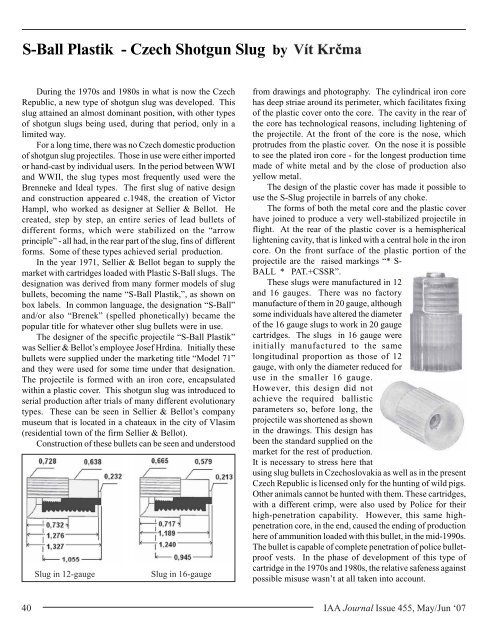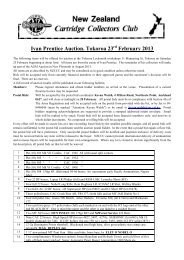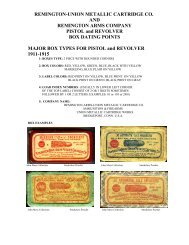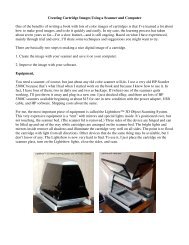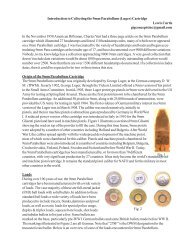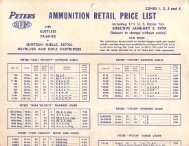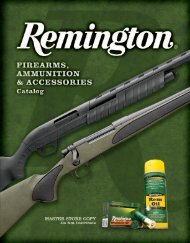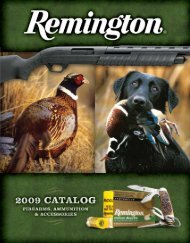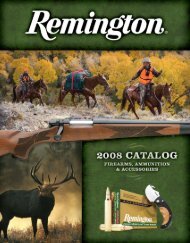Journal IA - International Ammunition Association
Journal IA - International Ammunition Association
Journal IA - International Ammunition Association
Create successful ePaper yourself
Turn your PDF publications into a flip-book with our unique Google optimized e-Paper software.
S-Ball Plastik - Czech Shotgun Slug by<br />
During the 1970s and 1980s in what is now the Czech<br />
Republic, a new type of shotgun slug was developed. This<br />
slug attained an almost dominant position, with other types<br />
of shotgun slugs being used, during that period, only in a<br />
limited way.<br />
For a long time, there was no Czech domestic production<br />
of shotgun slug projectiles. Those in use were either imported<br />
or hand-cast by individual users. In the period between WWI<br />
and WWII, the slug types most frequently used were the<br />
Brenneke and Ideal types. The first slug of native design<br />
and construction appeared c.1948, the creation of Victor<br />
Hampl, who worked as designer at Sellier & Bellot. He<br />
created, step by step, an entire series of lead bullets of<br />
different forms, which were stabilized on the “arrow<br />
principle” - all had, in the rear part of the slug, fins of different<br />
forms. Some of these types achieved serial production.<br />
In the year 1971, Sellier & Bellot began to supply the<br />
market with cartridges loaded with Plastic S-Ball slugs. The<br />
designation was derived from many former models of slug<br />
bullets, becoming the name “S-Ball Plastik,”, as shown on<br />
box labels. In common language, the designation “S-Ball”<br />
and/or also “Brenek” (spelled phonetically) became the<br />
popular title for whatever other slug bullets were in use.<br />
The designer of the specific projectile “S-Ball Plastik”<br />
was Sellier & Bellot’s employee Josef Hrdina. Initially these<br />
bullets were supplied under the marketing title “Model 71”<br />
and they were used for some time under that designation.<br />
The projectile is formed with an iron core, encapsulated<br />
within a plastic cover. This shotgun slug was introduced to<br />
serial production after trials of many different evolutionary<br />
types. These can be seen in Sellier & Bellot’s company<br />
museum that is located in a chateaux in the city of Vlasim<br />
(residential town of the firm Sellier & Bellot).<br />
Construction of these bullets can be seen and understood<br />
40<br />
Slug in 12-gauge Slug in 16-gauge<br />
from drawings and photography. The cylindrical iron core<br />
has deep striae around its perimeter, which facilitates fixing<br />
of the plastic cover onto the core. The cavity in the rear of<br />
the core has technological reasons, including lightening of<br />
the projectile. At the front of the core is the nose, which<br />
protrudes from the plastic cover. On the nose it is possible<br />
to see the plated iron core - for the longest production time<br />
made of white metal and by the close of production also<br />
yellow metal.<br />
The design of the plastic cover has made it possible to<br />
use the S-Slug projectile in barrels of any choke.<br />
The forms of both the metal core and the plastic cover<br />
have joined to produce a very well-stabilized projectile in<br />
flight. At the rear of the plastic cover is a hemispherical<br />
lightening cavity, that is linked with a central hole in the iron<br />
core. On the front surface of the plastic portion of the<br />
projectile are the raised markings “* S-<br />
BALL * PAT.+CSSR”.<br />
These slugs were manufactured in 12<br />
and 16 gauges. There was no factory<br />
manufacture of them in 20 gauge, although<br />
some individuals have altered the diameter<br />
of the 16 gauge slugs to work in 20 gauge<br />
cartridges. The slugs in 16 gauge were<br />
initially manufactured to the same<br />
longitudinal proportion as those of 12<br />
gauge, with only the diameter reduced for<br />
use in the smaller 16 gauge.<br />
However, this design did not<br />
achieve the required ballistic<br />
parameters so, before long, the<br />
projectile was shortened as shown<br />
in the drawings. This design has<br />
been the standard supplied on the<br />
market for the rest of production.<br />
It is necessary to stress here that<br />
using slug bullets in Czechoslovakia as well as in the present<br />
Czech Republic is licensed only for the hunting of wild pigs.<br />
Other animals cannot be hunted with them. These cartridges,<br />
with a different crimp, were also used by Police for their<br />
high-penetration capability. However, this same highpenetration<br />
core, in the end, caused the ending of production<br />
here of ammunition loaded with this bullet, in the mid-1990s.<br />
The bullet is capable of complete penetration of police bulletproof<br />
vests. In the phase of development of this type of<br />
cartridge in the 1970s and 1980s, the relative safeness against<br />
possible misuse wasn’t at all taken into account.<br />
<strong>IA</strong>A <strong>Journal</strong> Issue 455, May/Jun ‘07


